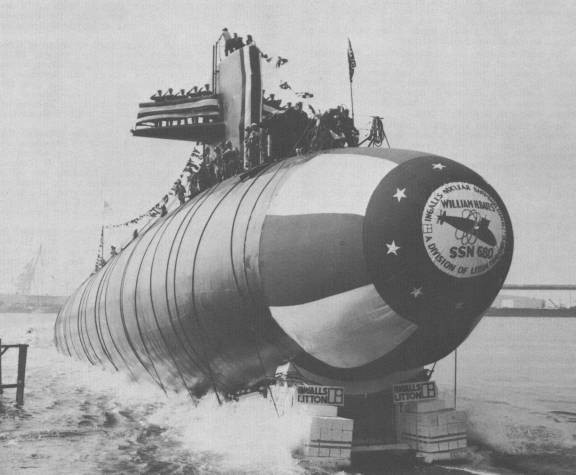William H. Bates (SSN-680)

(SSN-680: dp. 3,640 (surf.), 4,640 (subm.); l. 292'3"; b. 31'8"; dr. 27'; s. 15+ k. (surf.), 25+ k. (subm.); cpl. 108; a. 4 tt., SUBROC; cl. Sturgeon)
William Henry Bates, born on 26 April 1917 at Salem, Mass., enlisted in the Navy in July 1940. Commissioned as ensign in the Naval Reserve on 30 January 1941, Bates received instruction at the Naval Reserve Supply Officer's School at the Naval Medical Center, Washington, D.C., before serving successive tours of duty at the Washington Navy Yard and in Constellation (IX-20).
Bates remained in the Supply Corps through the end of World War II, participating in the Iwo Jima campaign in the spring of 1945 and eventually becoming the supply officer for the 4th Naval District by 1949. While Bates was stationed there, his father, Representative George J. Bates of the 6th Massachusetts Congressional District, was killed in a plane crash at the Washington (D.C.) National Airport on 1 November 1949.
Bates resigned his reserve commission, he had attained the rank of lieutenant commander by that time, on 14 February 1950, to fill the seat of his late father in the United States House of Representatives. For the nearly two decades preceding his death on 22 June 1969, Bates staunchly advocated a strong military posture for the United States. On the Joint Congressional Committee on Atomic Energy and the House Armed Services Committee, he vigorously supported the development of nuclear-powered naval vessels. He also vigorously backed incentive pay programs and the establishment of better housing facilities for servicemen. He constantly sought means to enhance the training, caliber, and morale of military personnel.
William H. Bates (SSN-680), originally projected as Redfish, was laid down on 4 August 1969 at Pascagoula, Miss., by the Ingalls Nuclear Shipbuilding Div. of Litton Industries; launched on 11 December 1971; sponsored by Mrs. Andrew R. Grainger, the wife of Ens. Andrew R. Grainger and the daughter of Representative Bates; and commissioned on 5 May 1973, Comdr. Glenn N. Arthur in command.
After shakedown, William H. Bates, homeported at New London, Conn.,, worked out of the submarine base at Groton. She was deployed to the eastern Atlantic between July and October 1974 and conducted her first patrol mission before visiting Holy Loch, Scotland, and Halifax, Nova Scotia, en route home. However, her respite was brief, for the nuclear attack submarine was again underway on patrol over the Christmas holidays and into January 1975. After voyage repairs at Holy Loch, William H. Bates shifted to Faslane, Scotland, for a port visit.
Sailing for home in late January, the submarine was refitted at the Norfolk Naval Shipyard, Portsmouth, Va., before conducting local operations off Ft. Lauderdale, Fla., into the summer of 1975. She was deployed to European waters again soon thereafter, taking part in antisubmarine warfare exercises. In November, the submarine took part in NATO Exercises "Moby Dick" and "Ocean Safari 75," before she returned to New London in December.
William. H. Bates conducted her first Mediterranean deployment the following year, departing New London on 5 May 1976. During this tour, she honed her skills in exercises with other ships of the United States Navy and other NATO naval units. During the deployment, she visited Bizerte, Tunisia; Augusta Bay, Sicily; and La Spezia and Naples, Italy. After departing the Mediterranean on 6 September 1976, the submarine took part in Exercise "Ocean Safari 76" in mid-month. On 14 October, the submarine returned to Groton.
William H. Bates underwent voyage repairs and later prepared for another overseas deployment. She departed Groton during the summer of 1977 and completed her assigned mission on 3 October, mooring alongside the tender Holland (AS-32) on that day. She subsequently transited the North Sea for a port visit to Bremerhaven, Germany, where she spent five days. William H. Bates then took part in Exercise "Ocean Safari 77" with NATO units while returning from European waters to Groton.
From there, William H. Bates operated in the Atlantic until moving to San Diego in May 1978 for service in the Pacific Fleet into 1980.


